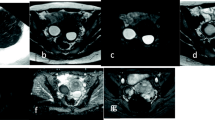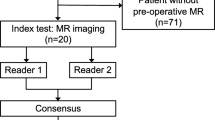Abstract
The utility of magnetic resonance imaging (MRI) in the selection, procedure planning, and follow-up of patients undergoing arterial embolization for uterine fibroids is reviewed. Advantages of MRI over ultrasound include multiplanar imaging capability, a larger field of view, increased spatial resolution, improved anatomic detail, and the ability to detect other pelvic disorders. MRI can assess fibroid viability by detecting contrast agent enhancement. Magnetic resonance angiography has a useful role in evaluation of pelvic vasculature. Magnetic resonance parameters such as T1 and T2 relaxation times and diffusion-weighted characteristics have an emerging role in predicting outcome before and after embolization. MRI may be used to evaluate technical success and to image potential complications after embolization.








Similar content being viewed by others
References
Nakai A, Togashi K, Kosaka K et al (2008) Do anticholinergic agents suppress uterine peristalsis and sporadic myometrial contractions at cine MR imaging? Radiology 246:489–496
Dueholm M, Lundorf E, Hansen ES et al (2002) Accuracy of magnetic resonance imaging and transvaginal ultrasonography in the diagnosis, mapping, and measurement of uterine myomas. Am J Obstet Gynecol 186:409–415
Spielmann AL, Keogh C, Forster BB et al (2006) Comparison of MRI and sonography in the preliminary evaluation for fibroid embolization. AJR Am J Roentgenol 187:1499–1504
Omary RA, Vasireddy S, Chrisman HB et al (2002) The effect of pelvic MR imaging on the diagnosis and treatment of women with presumed symptomatic uterine fibroids. J Vasc Interv Radiol 13:1149–1153
Volkers NA, Hehenkamp WJ, Spijkerboer AM et al (2008) MR reproducibility in the assessment of uterine fibroids for patients scheduled for uterine artery embolization. Cardiovasc Intervent Radiol 31:260–268
Lee JK, Gersell DJ, Balfe DM et al (1985) The uterus: in vitro MR-anatomic correlation of normal and abnormal specimens. Radiology 157:175–179
Yamashita Y, Torashima M, Takahashi M et al (1993) Hyperintense uterine leiomyoma at T2-weighted MR imaging: differentiation with dynamic enhanced MR imaging and clinical implications. Radiology 189:721–725
Shimada K, Ohashi I, Kasahara I et al (2004) Differentiation between completely hyalinized uterine leiomyomas and ordinary leiomyomas: three-phase dynamic magnetic resonance imaging (MRI) vs diffusion-weighted MRI with very small b-factors. J Magn Reson Imaging 20:97–104
Harman M, Zeteroğlu S, Arslan H et al (2006) Predictive value of magnetic resonance imaging signal and contrast-enhancement characteristics on post-embolization volume reduction of uterine fibroids. Acta Radiol 47:427–435
Burn PR, McCall JM, Chinn RJ et al (2000) Uterine fibroleiomyoma: MR imaging appearances before and after embolization of uterine arteries. Radiology 214:729–734
DeSouza NM, Williams AD (2002) Uterine arterial embolization for leiomyomas: perfusion and volume changes at MR imaging and relation to clinical outcome. Radiology 222:367–374
Jha RC, Ascher SM, Imaoka I, Spies JB (2000) Symptomatic fibroleiomyomata: MR imaging of the uterus before and after uterine arterial embolization. Radiology 217:228–235
Okizuka H, Sugimura K, Takemori M et al (1993) MR detection of degenerating uterine leiomyomas. J Comput Assist Tomogr 17:760–766
Tamai K, Koyama T, Umeoka S, Saga T, Fujii S, Togashi K (2006) Spectrum of MR features in adenomyosis. Best Pract Res Clin Obstet Gynaecol. 20(4):583–602
Siskin GP, Tublin ME, Stainken BF et al (2001) Uterine artery embolization for the treatment of adenomyosis: clinical response and evaluation with MR imaging. AJR Am J Roentgenol 177:297–302
Jha RC, Takahama J, Imaoka I et al (2003) Adenomyosis: MRI of the uterus treated with uterine artery embolization. AJR Am J Roentgenol 181:851–856
Kim MD, Kim S, Kim NK et al (2007) Long-term results of uterine artery embolization for symptomatic adenomyosis. AJR Am J Roentgenol 188:176–181
Worthington-Kirsch RL, Andrews RT, Siskin GP et al (2002) II. Uterine fibroid embolization: technical aspects. Tech Vasc Interv Radiol 5:17–34
Rha SE, Byun JY, Jung SE et al (2003) CT and MRI of uterine sarcomas and their mimickers. AJR Am J Roentgenol 181:1369–1374
Kitamura Y, Ascher SM, Cooper C et al (2005) Imaging manifestations of complications associated with uterine artery embolization. Radiographics 25(suppl 1):S119–S132
Pron G, Bennett J, Common A, Ontario Uterine Fibroid Embolization Collaboration Group et al (2003) The Ontario uterine fibroid embolization trial. Part 2. Uterine fibroid reduction and symptom relief after uterine artery embolization for fibroids. Fertil Steril 79:120–127
Tanaka YO, Nishida M, Tsunoda H et al (2004) Smooth muscle tumors of uncertain malignant potential and leiomyosarcomas of the uterus: MR findings. J Magn Reson Imaging 20:998–1007
Namimoto T, Yamashita Y, Awai K et al (2009) Combined use of T2-weighted and diffusion-weighted 3-T MR imaging for differentiating uterine sarcomas from benign leiomyomas. Eur Radiol 19:2756–2764
Takeuchi M, Matsuzaki K, Nishitani H (2009) Hyperintense uterine myometrial masses on T2-weighted magnetic resonance imaging: differentiation with diffusion-weighted magnetic resonance imaging. J Comput Assist Tomogr 33:834–837
Kilickesmez O, Bayramoglu S, Inci E et al (2009) Quantitative diffusion-weighted magnetic resonance imaging of normal and diseased uterine zones. Acta Radiol 50:340–347
Tamai K, Koyama T, Saga T et al (2008) The utility of diffusion-weighted MR imaging for differentiating uterine sarcomas from benign leiomyomas. Eur Radiol 18:723–730
Spies JB, Roth AR, Jha RC et al (2002) Leiomyomata treated with uterine artery embolization: factors associated with successful symptom and imaging outcome. Radiology 222:45–52
Katsumori T, Nakajima K, Mihara T (2003) Is a large fibroid a high-risk factor for uterine artery embolization? AJR Am J Roentgenol 181:1309–1314
Firouznia K, Ghanaati H, Sanaati M et al (2008) Uterine artery embolization in 101 cases of uterine fibroids: do size, location, and number of fibroids affect therapeutic success and complications? Cardiovasc Intervent Radiol 31:521–526
Verma SK, Gonsalves CF, Baltarowich OH et al (2010) Spectrum of imaging findings on MRI and CT after uterine artery embolization. Abdom Imaging 35:118–128
Goodwin SC, Bonilla SC, Sacks D, Reporting Standards for Uterine Artery Embolization (UAE) Subcommittee, UAE Task Force Standards Subcommittee, Society of Interventional Radiology Technology Assessment Committee et al (2003) Reporting standards for uterine artery embolization for the treatment of uterine leiomyomata. J Vasc Interv Radiol 14(9 pt 2):S467–S476
McLucas B, Adler L, Perrella R (2001) Uterine fibroid embolization: nonsurgical treatment for symptomatic fibroids. J Am Coll Surg 192:95–105
Katsumori T, Akazawa K, Mihara T (2005) Uterine artery embolization for pedunculated subserosal fibroids. AJR Am J Roentgenol 184:399–402
Margau R, Simons ME, Rajan DK et al (2008) Outcomes after uterine artery embolization for pedunculated subserosal leiomyomas. J Vasc Interv Radiol 19:657–661
Toor SS, Tan KT, Simons ME et al (2008) Clinical failure after uterine artery embolization: evaluation of patient and MR imaging characteristics. J Vasc Interv Radiol 19:662–667
Hricak H, Finck S, Honda G, Goranson H (1992) MR imaging in the evaluation of benign uterine masses: value of gadopentetate dimeglumine–enhanced T1-weighted images. AJR Am J Roentgenol 158:1043–1050
Hovsepian DM, Siskin GP, Bonn J, CIRSE, SIR Standards of Practice Committees et al (2004) Quality improvement guidelines for uterine artery embolization for symptomatic leiomyomata. J Vasc Interv Radiol 15:535–542
Nikolaidis P, Siddiqi AJ, Carr JC et al (2005) Incidence of nonviable leiomyomas on contrast material–enhanced pelvic MR imaging in patients referred for uterine artery embolization. J Vasc Interv Radiol 16:1465–1471
Naguib NN, Nour-Eldin NE, Hammerstingl RM et al (2008) Three-dimensional reconstructed contrast-enhanced MR angiography for internal iliac artery branch visualization before uterine artery embolization. J Vasc Interv Radiol 19:1569–1575
Mori K, Shiigai M, Ueda T et al (2008) Assessment of the uterine artery before uterine arterial embolization: comparison of unenhanced 3D water-excitation sensitivity-encoding time-of-flight (WEST) and gadolinium-enhanced 3D sensitivity-encoding water-excitation multishot echo-planar (SWEEP) MR angiography. J Magn Reson Imaging 27:557–562
Naguib NN, Nour-Eldin NE, Lehnert T et al (2009) Uterine artery embolization: optimization with preprocedural prediction of the best tube angle obliquity by using 3D-reconstructed contrast-enhanced MR angiography. Radiology 251:788–795
Walker WJ, Pelage JP (2002) Uterine artery embolisation for symptomatic fibroids: clinical results in 400 women with imaging follow up. BJOG 109:1262–1272
Chrisman HB, Saker MB, Ryu RK et al (2000) The impact of uterine fibroid embolization on resumption of menses and ovarian function. J Vasc Interv Radiol 11:699–703
Gomez-Jorge J, Keyoung A, Levy EB, Spies JB (2003) Uterine artery anatomy relevant to uterine leiomyomata embolization. Cardiovasc Intervent Radiol 26:522–527
Razavi MK, Wolanske KA, Hwang GL et al (2002) Angiographic classification of ovarian artery-to-uterine artery anastomoses: initial observations in uterine fibroid embolization. Radiology 224:707–712
Binkert CA, Andrews RT, Kaufman JA (2001) Utility of nonselective abdominal aortography in demonstrating ovarian artery collaterals in patients undergoing uterine artery embolization for fibroids. J Vasc Interv Radiol 12:841–845
Kroencke TJ, Scheurig C, Kluner C et al (2006) Uterine fibroids: contrast-enhanced MR angiography to predict ovarian artery supply—initial experience. Radiology 241:181–189
Burbank F (2004) Childbirth and myoma treatment by uterine artery occlusion: do they share a common biology? J Am Assoc Gynecol Laparosc 11:138–152
Aziz A, Petrucco OM, Makinoda S et al (1998) Transarterial embolization of the uterine arteries: patient reactions and effects on uterine vasculature. Acta Obstet Gynecol Scand 77:334–340
Shimada K, Ohashi I, Kasahara I et al (2004) Triple-phase dynamic MRI of intratumoral vessel density and hyalinization grade in uterine leiomyomas. AJR Am J Roentgenol 182:1043–1050
Kosaka N, Uematsu H, Kimura H et al (2007) Assessment of the vascularity of uterine leiomyomas using double-echo dynamic perfusion-weighted MRI with the first-pass pharmacokinetic model: correlation with histopathology. Invest Radiol 42:629–635
Goodwin SC, McLucas B, Lee M et al (1999) Uterine artery embolization for the treatment of uterine leiomyomata midterm results. J Vasc Interv Radiol 10:1159–1165
Yousefi S, Czeyda-Pommersheim F, White AM et al (2006) Repeat uterine artery embolization: indications and technical findings. J Vasc Interv Radiol 17:1923–1929
Chrisman HB, West D, Corpuz B et al (2005) Primary failure of uterine artery embolization: use of magnetic resonance imaging to select patients for repeated embolization. J Vasc Interv Radiol 16:1143–1147
Katsumori T, Kasahara T, Kin Y, Nozaki T (2008) Infarction of uterine fibroids after embolization: relationship between postprocedural enhanced MRI findings and long-term clinical outcomes. Cardiovasc Intervent Radiol 31:66–72
Liapi E, Kamel IR, Bluemke DA et al (2005) Assessment of response of uterine fibroids and myometrium to embolization using diffusion-weighted echoplanar MR imaging. J Comput Assist Tomogr 29:83–86
Clark TW, Do RK, Kang S et al (2009) Can functional MRI predict volume reduction following uterine fibroid embolization? (abstract 86). J Vasc Interv Radiol 2:S34
Volkers NA, Hehenkamp WJ, Birnie E et al (2006) Uterine artery embolization in the treatment of symptomatic uterine fibroid tumors (EMMY Trial): periprocedural results and complications. J Vasc Interv Radiol 17:471–480
Society of Obstetricians, Gynaecologists of Canada (2005) SOGC clinical practice guidelines. Uterine fibroid embolization. No. 150, October 2004. Int J Gynaecol Obstet 89:305–318
Colgan TJ, Pron G, Mocarski EJ et al (2003) Pathologic features of uteri and leiomyomas following uterine artery embolization for leiomyomas. Am J Surg Pathol 27:167–177
Gabriel H, Pinto CM, Kumar M et al (2004) MRI detection of uterine necrosis after uterine artery embolization for fibroids. AJR Am J Roentgenol 183:733–736
Torigian DA, Siegelman ES, Terhune KP et al (2005) MRI of uterine necrosis after uterine artery embolization for treatment of uterine leiomyomata. AJR Am J Roentgenol 184:555–559
Siddiqi AJ, Chrisman HB, Vogelzang RL et al (2006) MR imaging evidence of reversal of uterine ischemia after uterine artery embolization for leiomyomata. J Vasc Interv Radiol 17:1535–1538
Volkers NA, Hehenkamp WJ, Smit P et al (2008) Economic evaluation of uterine artery embolization versus hysterectomy in the treatment of symptomatic uterine fibroids: results from the randomized EMMY trial. J Vasc Interv Radiol 19:1007–1016
Wu O, Briggs A, Dutton S et al (2007) Uterine artery embolisation or hysterectomy for the treatment of symptomatic uterine fibroids: a cost–utility analysis of the HOPEFUL study. BJOG 114:1352–1362
Conflict of interest
The authors declare that they have no conflict of interest.
Author information
Authors and Affiliations
Corresponding author
Rights and permissions
About this article
Cite this article
Kirby, J.M., Burrows, D., Haider, E. et al. Utility of MRI Before and After Uterine Fibroid Embolization: Why to Do It and What to Look For. Cardiovasc Intervent Radiol 34, 705–716 (2011). https://doi.org/10.1007/s00270-010-0029-2
Received:
Accepted:
Published:
Issue Date:
DOI: https://doi.org/10.1007/s00270-010-0029-2




